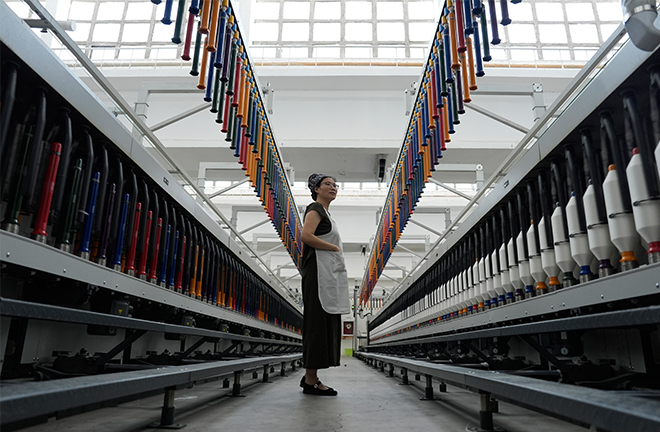Counties play key role in nation’s high-quality development

A worker checks automated production lines at the workshop of a textile science and technology company in Wulian County, Rizhao City, Shandong Province. Photo: IC PHOTO
Kunshan, a county-level city in east China’s Jiangsu Province, has leveraged its strengths in electronic information and high-end equipment manufacturing to venture into future industries such as artificial intelligence and the metaverse, fostering an industrial cluster worth trillions of yuan. Jiangyin, another county-level city in the province, has capitalized on its traditional manufacturing base to establish multiple industrial chains exceeding 100 billion yuan in value. Centering on its “crayfish economy,” the province’s Xuyi County has developed a distinctive brand through the integration of its primary, secondary, and tertiary industries.
These county-level areas have responded actively to the central government’s call for boosting the development of county economies, as the Third Plenary Session of the 20th CPC Central Committee emphasized the need to “expand county industries that benefit local people.” This priority was reinforced in the 2025 No.1 Central Document and government work report, underscoring the increasing significance of county economies as foundational units of China’s national economy and key drivers of high-quality economic and social development.
Significance of county economies
China’s administrative landscape includes over 1,300 counties, more than 300 county-level cities, and hundreds of comparable administrative entities, such as autonomous counties, banners, and special zones. According to Peng Diyun, a professor from the School of Economics and Management at Nanchang University, counties serve as critical bridges between urban and rural areas and key players in rural oversight. Their role has evolved from “twilight zones” between cities and the countryside to “strategic pivots” in regional economic planning. No longer passive recipients of economic shifts, they are now active pillars in a development model based on regional synergy and high-quality development.
Counties account for nearly 40% of China’s GDP, with enterprises above the designated size making up 46% of the national total. Huang Kainan, a professor at Shandong University, emphasized that county economies have become crucial hubs for local employment opportunities and serve as vital platforms for absorbing returning rural labor.
As focal points where national strategies such as rural revitalization, new urbanization, integrated urban-rural development, and new industrialization converge, counties hold immense potential for China’s economic growth and act as pivotal frontiers for high-quality development, Huang added.
Robust momentum
Driven by the national strategies of rural revitalization and coordinated regional development, China’s county economies have demonstrated steady growth in both scale and structural optimization. This momentum highlights the resilience and vitality of the broader Chinese economy. According to Huang, between 2020 and 2024, the combined GDP of counties nationwide expanded from 39 trillion yuan to 54 trillion yuan, with the tertiary sector’s share continuing to rise. Modern service industries, such as e-commerce and cultural tourism, have flourished, while county urbanization rates climbed from 44.5% to 50%. Significant improvements in infrastructure and public services have further consolidated the foundation for common prosperity.
Currently, county economies are undergoing diversification in development models, industrial upgrading, and regional coordination. Huo Weidong, director of the Institute of County Economies at Liaoning University, cited Kunshan, Jiangyin, and Xuyi in Jiangsu Province as examples, illustrating how county economies are accelerating the transformation and upgrade of traditional industries to advance urban-rural integration and rural revitalization by leveraging regional comparative advantages and through technological innovation, financial support, and policy guidance.
Bright prospects
In recent years, counties have made notable strides in advancing new industrialization and transitioning to more sophisticated economic structures. Their role in boosting domestic consumption, safeguarding food security, and preserving ecological balance is becoming increasingly indispensable. By analyzing Kunshan’s success, Huo predicted that counties will play a vital role in absorbing relocated industries, optimizing urban-rural resource allocation, and stimulating the endogenous impetus of regional development.
Wu Yin, a professor of economics at the Southwest University of Finance and Economics, underscored county economies’ extensive reach, moderate scale, and strong driving force, making them crucial for spatial accommodation, social inclusivity, and demographic concentration. Their continued high-quality development will enhance planning, infrastructure, and governance in both urban and rural areas, with more balanced distribution, flow, and integration of populations across regions.
Peng further emphasized the strategic importance of counties in China’s modernization drive, envisioning them as “ballast stones” for national economic security, “powerhouses” for new urbanization, lower-tier “testing grounds” for technological innovation, and “equalizers” for common prosperity.
Edited by CHEN MIRONG
